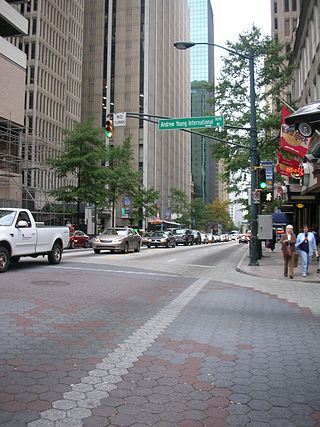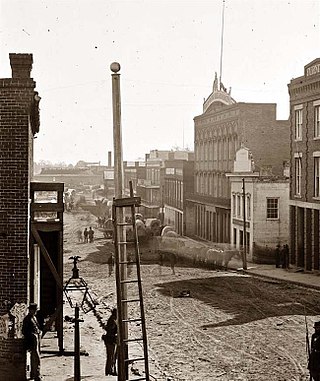
Georgia-Pacific Center is a 212.45 m (697.0 ft), 1,567,011 sq.ft skyscraper in downtown Atlanta, Georgia, United States. It contains 52 stories of office space and was finished in 1982. Before the six-year era of tall skyscrapers to be built in Atlanta, it was Atlanta's second-tallest building from 1982 to 1987. It has a stair-like design that staggers down to the ground, and is clad in pink granite quarried from Marble Falls, Texas.

The history of Atlanta dates back to 1836, when Georgia decided to build a railroad to the U.S. Midwest and a location was chosen to be the line's terminus. The stake marking the founding of "Terminus" was driven into the ground in 1837. In 1839, homes and a store were built there and the settlement grew. Between 1845 and 1854, rail lines arrived from four different directions, and the rapidly growing town quickly became the rail hub for the entire Southern United States. During the American Civil War, Atlanta, as a distribution hub, became the target of a major Union campaign, and in 1864, Union William Sherman's troops set on fire and destroyed the city's assets and buildings, save churches and hospitals. After the war, the population grew rapidly, as did manufacturing, while the city retained its role as a rail hub. Coca-Cola was launched here in 1886 and grew into an Atlanta-based world empire. Electric streetcars arrived in 1889, and the city added new "streetcar suburbs".

Peachtree Street is one of several major streets running through the city of Atlanta, Georgia, United States. Beginning at Five Points in downtown Atlanta, it runs North through Midtown; a few blocks after entering into Buckhead, the name changes to Peachtree Road at Palisades Road. Much of the city's historic and noteworthy architecture is located along the street, and it is often used for annual parades,, as well as one-time parades celebrating events such as the 100th anniversary of Coca-Cola in 1986 and the Atlanta Braves' 1995 and 2021 World Series victories.

Midtown Atlanta, or Midtown, is a high-density commercial and residential neighborhood of Atlanta, Georgia. The exact geographical extent of the area is ill-defined due to differing definitions used by the city, residents, and local business groups. However, the commercial core of the area is anchored by a series of high-rise office buildings, condominiums, hotels, and high-end retail along Peachtree Street between North Avenue and 17th Street. Midtown, situated between Downtown to the south and Buckhead to the north, is the second-largest business district in Metro Atlanta. In 2011, Midtown had a resident population of 41,681 and a business population of 81,418.

Five Points is a district of Atlanta, Georgia, United States, the primary reference for the downtown area.

Livingston Mims was an American politician who served as the 37th mayor of Atlanta, Georgia during the early 20th century.

Rich's was a department store retail chain, headquartered in Atlanta, Georgia, which operated in the southern U.S. from 1867 until March 6, 2005 when the nameplate was eliminated and replaced by Macy's. Many of the former Rich's stores today form the core of Macy's Central, an Atlanta-based division of Macy's, Inc., which formerly operated as Federated Department Stores, Inc.

Davison's of Atlanta was a department store chain and an Atlanta shopping institution. It was the major competition to Rich's and it took the Macy's name in 1986.

South Downtown is a historic neighborhood of Downtown Atlanta, Georgia, United States. South Downtown is primarily home to city, county, state, and federal governmental offices, which prompted the city to adopt signage declaring the area "Government Walk." Although much of South Downtown is dominated by surface parking lots, the neighborhood was passed over during the redevelopment boom of the 1960s and 1970s that resulted in the demolition of much of Downtown's architecturally significant buildings. The result is myriad buildings from the 1950s and earlier that retain their historic structural integrity.

The Rufus M. Rose House is a late Victorian, Queen Anne style house located in the SoNo district of Atlanta, Georgia. Occupying a narrow lot on Peachtree Street, one and a half blocks south of North Avenue, the house was built in 1901 for Dr. Rufus Mathewson Rose. The architect was Emil Charles Seiz (1873–1940), who designed many residential and commercial structures in the city, including the 1924 Massellton Apartments on Ponce de Leon Avenue.

The Piedmont Hotel was a hotel in Downtown Atlanta, Georgia, United States. Construction on the building, which was designed by architect Willis F. Denny, began in 1901, and the building was opened to the public in January 1903. Considered one of the finest hotels in the city at the time, numerous famous guests stayed at the hotel while visiting Atlanta, including three presidents of the United States. Unlike other Atlanta hotels, the Piedmont sought to emulate the style of hotels in the northeastern United States and was commonly referred to by locals as "our New York City hotel". In 1929, the building went through an extensive renovation overseen by the architectural firm of Pringle & Smith. In 1965, the owners of the hotel agreed to sell the property to the Equitable Life Assurance Society of the United States, who planned to build a new office building on the site. The hotel was demolished that year and in 1968, the Equitable Building was completed.
The Chamberlin-Johnson-DuBose Company was a leading department store in Atlanta from 1866 until 1931, competing with Rich's.

Joseph Madison High (1855–1906) was the founder of Atlanta department store J.M. High Company. His wife, Harriet "Hattie" Harwell Wilson High (1862–1932), donated her family's mansion on Peachtree Street to house the museum that has grown into the High Museum of Art, Atlanta's foremost art museum.

Dr. Henry Lumpkin Wilson was an American physician, city councilman, and was active in the city of Atlanta's expansion and development.

The Peachtree Arcade was a shopping arcade in downtown Atlanta, Georgia, United States. The building, modeled after the Arcade in Cleveland, was designed by Atlanta-based architect A. Ten Eyck Brown and was located between Peachtree Street and Broad Street near Five Points. Construction began in 1917 and was completed the following year. Located in the city's central business district, it was very popular with citizens, functioning as an unofficial "civic center" for the city. However, by the 1960s, the arcade was facing increased competition from shopping malls located in Atlanta's suburbs, and in 1964, the building was demolished to make way for the First National Bank Building, a skyscraper that, at the time of its construction, was the tallest building in both Atlanta and the southeastern United States. In 1993, the American Institute of Architects named the building as one of Atlanta's most notable landmarks to have been destroyed.

Marietta Street is a historic street in Downtown Atlanta. The street leads from Atlanta towards the town of Marietta, as its name indicates. It begins as one of the five streets intersecting at Five Points, leading northwest, forming the southern border of Downtown's Fairlie-Poplar district, continuing through Downtown's Luckie Marietta district, then entering West Midtown's Marietta Street Artery neighborhood, until terminating at its junction with West Marietta St., Brady Ave., and 8th St.

The M. Rich Building, also known as the M. Rich and Brothers and Company Building and the W. T. Grant Building at 82 Peachtree Street SW, Atlanta, is a landmark building significant for both architectural and commercial reasons. It housed Rich's department store from the time it was completed in 1907 until it moved into its much larger premises at Broad and Alabama streets in 1924.

200 Peachtree is a mixed-use retail center in downtown Atlanta, Georgia designed by Philip T. Shutze and Starrett & van Vleck. Built in 1927 as the flagship department store for Davison's, the last department store in the building closed in 2003. The building later underwent an extensive renovation in the 2010s.

The Whitehall Street Retail Historic District is a historic district in Atlanta, Georgia, United States. The district is centered on Peachtree Street and Martin Luther King Jr. Drive and includes Broad, Forsyth, and Mitchell Streets. It was added to the National Register of Historic Places in 2020.
















